I realized recently that I had no hanhaba obi that were not hakata weave. I told myself I should probably remedy that and then promptly got distracted by bigger and shinier things. Such is life. Thankfully, I stumbled across the listing for this little beauty on eBay with less than a few hours to go, tossed out a bid, and won it for a song. The pictures portrayed it as sort of a flat purple with yellow which seemed cute but not particularly exceptional. Imagine my pleased surprise when I opened the mail to discover a rich, shimmering aubergine with bronze accents and a bronzey-gold back side. I am not sure what I’m going to wear it with yet, but it’s beautiful, multi-seasonal, and dressy enough to wear with more slightly formal kimono. I’m so pleased!
Month: November 2010
Birthday dinner at Sakura
My birthday is on this coming Tuesday, but I hate having long, relaxing dinners (especially ones with alcohol involved) during the work-week, so I invited a few friends and my folks to come dinner at a restaurant I’d been wanting to try, Sakura on de la Montagne. I read that the waitresses and staff wore kimono, so I figured I would not stand out too much if I wore one too. What I was not anticipating is that the entire restaurant staff would be Japanese and dressed in simple komon and relatively informal obi. Enter one gigantic white person in a rather dressy kimono and even dressier obi, and hilarity ensues.
I chose to wear an outfit comprised of nothing but gifts, and I still cannot believe how perfectly everything worked out. I paired the pink Takara houmongi from Arian with the Stations of the Tokaido obi from Suara, and finished it off with a beautiful haneri from Naomi and obiage and obijime from my dear friend Jeff. Even the shawl was a gift – my grandmother crocheted it.
The restaurant was absolutely lovely. The decor was decidedly Japanese and we sat in a tatami room, but it was subtle and tasteful – not a cheesy theme restaurant, which unfortunately are the norm around here. The owner, Ishii Noriko-san, was incredibly kind and fussed over my outfit repeatedly. She’s offered to contact a Japanese tutor for me, and insisted I come back again in kimono. The food was delicious and the wait staff were all very kind. They allowed me to order off the “other” menu – the one intended for the Japanese clientele, and I had unadon. They also found out the dinner was for my birthday, and brought the table some delicious green tea ice cream (mine had a sparkler in it!) as well as a special box of yokan for me. I was incredibly touched.
My mother took a photo of Noriko-san and I. Doesn’t she look stylish? I loved her obi so much! This photo also does a great job of illustrating why clothing made for the average Japanese woman is so difficult for me to wear.
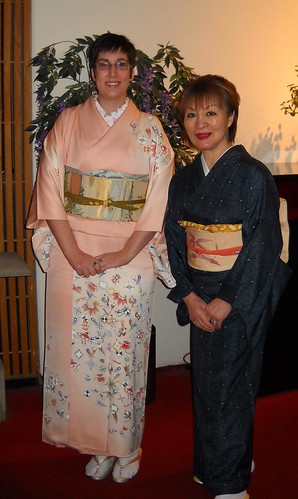
Uchikake in the front receiving room
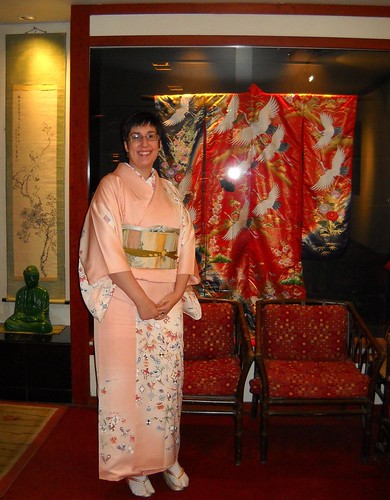


Delicious courses of dinner – shrimp gyoza, salad, sushi, dessert.


Delicious unadon. This wasn’t on the regular menu, I had to special-order it from the “Japanese people” menu XD. I love me some grilled eel. Next time though, I think I will try the katsudon!
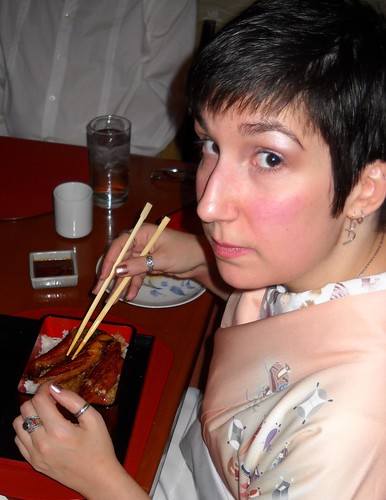
I was incredibly surprised and touched when Noriko-san came in with my special birthday yokan.


I also received some incredibly sweet gifts, Andy got me a DVD of a spy series I know he is very fond of, The Sandbaggers, and Leslie gave me two beautiful antique woodblock prints by Kunisada that she purchased in Japan quite a while ago. I was so touched. The whole evening was wonderful.
Knowledge: Types of Obi
Once you’ve figured out what kind of kimono is appropriate for your event or lifestyle, you’ll need to pair it with an obi. Deciding which kind of obi to wear can be even more overwhelming than picking the kimono. Hopefully this will help guide you in the right general direction!
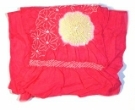
Heko
Heko obi are very casual, and are used primarily by children wearing yukata. It’s starting to become more common for adults to wear them, but again they’re in a very casual context. They are the only obi that is very soft and flowing, and almost looks more like a delicate scarf than any other obi. They’re typically tied in loose, flowing bows.
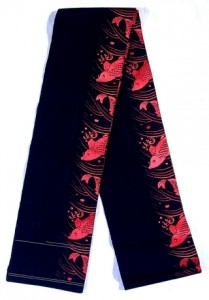
Hanhaba
Hanhaba essentially means “half width”, and that is exactly what these obi are. Most obi need to be folded in half while wrapped around the waist, and start out at a measurement of approximately one foot or 30cm wide. Hanhaba obi are half this width, and are generally much easier to tie in all sorts of cute musubi (bows). They’re normally quite casual, but every so often you can find one made of finer, more solid fabrics that are more appropriate for slightly dressier kimono.
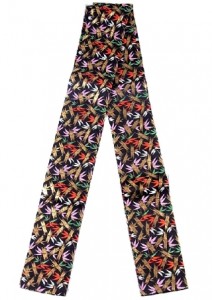
Tenga
These are a relatively new and not-so-common obi that are the size of hanhaba, but tend to have a lot of metallic brocade or embroidery and celebratory motifs. They can be worn with more formal kimono than a regular hanhaba would.
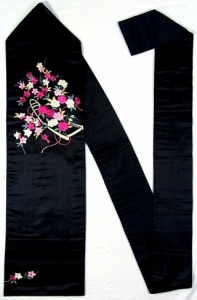
Nagoya
Nagoya obi have a very distinctive shape, they are narrow for approximately two thirds of the length and then they flare out to full width for the end. This makes them much easier to wrap around the waist, but still able to tie a slightly dressier musubi like otaiko or tsunodashi. They can vary from quite casual to quite dressy. Casual nagoya obi are often a solid colour with a small design embroidered or painted on the section that ends up on the front of the waist, and another coordinating design that ends up on the back of the drum bow. More dressy nagoya obi tend to have an all-over pattern and can often include metallic threads. Sometimes the wider end will also be long enough to tie a very formal drum like the niijudaiko. The type of kimono they can be worn with depends on the formality of the kimono.
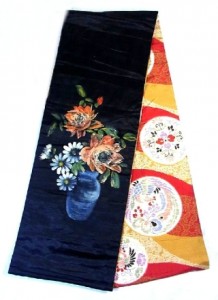
Chuuya
Literally night-and-day obi, chuya have fallen out of favour. They were very much in style during earlier eras, and are typefied their reversible duality – pale sublte “daytime” designs on one side and dark or more vivid “nighttime” designs on the other. They may also be patterned on one side and solid black on the other. These obi are 12″ wide, like fukuro, and can be used in a fair number of musubi, but due to the fact that they are generally nearly 100 years old, they tend to be slightly fragile. They are also often softer and “floppier” than modern wide obi, which adds a bit of casual feel to an outfit.
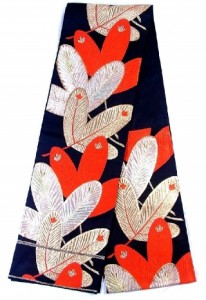
Fukuro
The longest obi, and therefore the easiest to tie fun and funky musubi with. They are the same width, approximately 30cm, the entire length. They are generally patterned on only 60% of the obi – the parts that remain hidden are solid to save on weight and money. Higher-end fukuro obi may be fully patterned. They are generally worn with furisode, houmongi, and tomesode, but can also be paired with iromuji and tsukesage in certain situations.
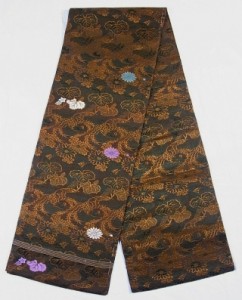
Maru
Maru obi are are the most formal obi. They are fully patterned on both sides, and often contain a fair bit of metallic brocade. Patterns can be either very tiny scale (typically seen on much older maru obi) or quite bold and large (more modern). They can be worn with any formal kimono, however they are usually a bit shorter than fukuro obi, which makes tying furisode-appropriate musubi a bit of a challenge.
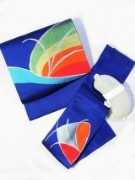
Tsuke-obi, also known as tsukuri obi or easy obi
These are kind of an odd duck. They are pre-tied, generally in two pieces. One narrow part ties snugly around the waist, and then a tied bow or knot tucks into the back. They’re used by women who don’t have a lot of experience dressing, women in a rush, or people who have to do frequent and quick costume changes like dancers or theatre performers. You can’t lump tsuke obi into one formality category, as they exist in nearly every level; from casual yukata obi to heavy gold fukuro obi in elaborate musubi to darari-style (see below) for dances and cosplay. Some people consider them “cheating”, but I consider them a good way to save a few minutes, or a good way to salvage an old or stained obi that would otherwise be unuseable. I am in the process of converting one myself, and will post the results once I am satisfied with them.
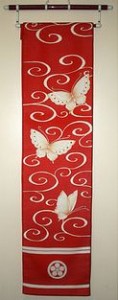
Darari
Darari, or dangling obi, are worn strictly by maiko, or apprentice geisha. They are more than twice as long as a regular obi, and will nearly always have the mon (crest) of the geisha house the maiko lives at on one end, to help identify where they are from. The patterns are always bold and vibrant, much like the maiko themselves. They are tied in a manner also referred to as darari, with two long hanging tails that remind me of folded butterfly wings.
*Darari obi image used with permission courtesy of Christina Stoppa/GoldenPhoenix/Kurokami
*Thanks to Ichiroya for the permitted use of their images. Originally these items were all available for purchase and the images linked back to the sale listings, but they have been sold!
Pink Takara Houmongi
I’m not generally attracted to pink kimono, or kimono with lots of small scattered designs. And yet somehow, this thing captivated me from the moment I saw it. The first time it was listed I forgot to bid and kicked myself repeatedly for missing out on it. I guess nobody else bid either, because a few days later it was listed again at an even lower price. I couldn’t believe my luck. I bid on it immediately so I wouldn’t forget, and hoped nobody else would bid either.
The end of the auction was coming up but I had to get to bed, so I asked Naomi‘s husband Arian to keep an eye on it for me. He decided to do so by outbidding me by 50 cents. He’s quite a goof sometimes, but a very sweet goof. In any case, I’m very grateful, because it’s absolutely gorgeous.
It’s a delicate soft salmon pink with white bokashi (fade-dyeing) around the shoulder and hem. Within the white areas, there are tiny Takara or Lucky Treasures motifs.
Takara-zukushi is a pattern of assembled “takara”, or treasures, which reflect what Japanese people consider valuable.
Needless to say, “takara” comprises of sacks of gold and magical mallets of luck. Buddhist scriptures which can give you knowledge and wisdom is a major treasure too. Counterweights are also “takara” although it may sound odd to you, because they are used as a balance when valuables are weighed. As for the rest of the treasures, “choji” (an herbal medicinal ingredient), “mino” (straw raincoat) and “kasa” (wattle hat) all symbolize something to protect oneself with against calamities and are therefore also considered “takara”.
The sense of “takara” varies by era and locality. Sometimes it comprises of locks, keys, and even ritual articles.
Trying to identify each treasure in a Takara-zukushi pattern is just like opening a jewelry box. In the mood for a treasure hunt? How about looking for interesting and unique treasures on kimonos or obis with the Takara-zukushi pattern!!
Explanation courtesy of Yamatoku.
I am hoping to be able to wear it on my birthday, and I’m going to aim for a very soft, girly, Kimono Salon-style coordination, pairing it up with the beautiful Tokaido obi I received as a gift recently.
Giving an old obi new life
When I first started this blog, I posted about my amazing crow obi, and mentioned that the silk backing had rotted out due to age, and I had plans to replace it.
Fast forward um, a year and a bit, and my procrastinating self has finally accomplished something! The obi fabric and original lining had been sitting folded in a bag for quite a while and I decided it was high time to finally give it the respect it deserves. If you’ve ever been curious about the construction of an obi, or have an obi yourself that needs to be redone, please read on!
The first step was to separate the obi silk from the obi-shin (stiffening core). They were not sewn together, but have been stuck to each other for what may be nearly a century at this point, so this involved a bit of careful peeling apart.


Isn’t my kitty ironing board cute? You’ll be seeing an awful lot of it in this entry XD
Once the two pieces were separated, I carefully ironed the seam allowance of the obi silk open. I ironed it enough to make the piece lie flat, but left the original fold line visible so I would have a straight line to sew along later without having to mark up the fabric.


Here is the whole piece with the seam allowance ironed flat. You can see how much the colour has faded over the years, but since the allowance will be hidden this isn’t really a problem. I just thought it was interesting and worth sharing.

The next step was to pin the wrong sides together of the obi silk and the black satin I was using for a backing piece. This was exceptionally tedious and I pricked my fingers several times!

Here’s the entire thing pinned together and taking up too much space on my floor. Yes, there is a disgusting area rug on top of disgusting wall-to-wall carpet on my basement. The floor gets cold so I’d rather icky and comfortable over stylish but clammy!

Once everything was pinned together, the next logical step was sewing. Lots and lots and lots of sewing. Due to the fragile nature of the silk and the fact that the obi gets tugged and pulled a lot, this all had to be done by hand, in a closely-spaced but loose slip stitch. I saved a huge amount of time by doing Japanese-style hand-stitching. This is hard to explain, but it basically involves holding the needle still and rocking the thread back and forth until a handful of stitches are lined up on the needle, and then pulling it through. This video gives an amazing visual demonstration with no explanation needed. Once you get the hang of sewing like this, it is an enormous time-saver.

Once both long sides are completely sewn, I ironed the seam allowances down again so it would lie flat. I found it easiest to do one fabric and then the other, rather than trying to press both sides at the same time.

Once the outer parts of the obi were sewn together, I folded them carefully, put them aside, and got to work on the shin (core). An obi is constructed somewhat like a sandwich, with the two visible pieces of silk on the outside, like the “bread”, and the shin in the centre, like a filling. The shin is usually a piece of heavy cloth, sometimes flannel, sometimes duck-cloth, and it serves to give body and stiffness to the obi. Without the shin, the obi would not lie flat and smooth when wrapped and tied around the body. If you’ve ever seen a cosplayer with a really crumpled, lumpy obi that has sort of collapsed on itself over the course of the day, odds are they made themselves an obi without using any sort of a shin or core.
The obi had a shin inside of it, a sort of brushed flannel-y material, but it had gotten incredibly soft over the years, so I decided to reinforce it. I found a roll of obi-shin fabric on eBay, but if you can’t find one specifically, any thicker fabric with a bit of body will work. Because the fabric of the obi itself is so thin, I figured a bit of extra stiffness would be good and used both the old shin and the new one together.

I used the old shin to determine the size of the new one. After I’d folded it to match the size of the old piece, I pinned it down and ironed it flat so it would stay in shape.


I pinned both shin together temporarily, just to make them easier to deal with and prevent things from shifting around while I worked.


With the two pieces pinned together, it was much easier to lay them out and tuck them into the folded seam allowances of the obi lining. Thankfully, I had assistance in the form of a Tribble. And yes, that is her tongue sticking out in the large version. For a mutt-cat, she is incredibly brachycephalic and tends to leave her tongue hanging out a bit because it doesn’t fit in her mouth properly. Poor boo.


Once all the pieces were sandwiched together inside-out, the next step was to turn the whole thing right-side-out. First step was to remove all the pins to make sure none got trapped inside when I was done. Unfortunately I do not have any photos of this phase, because both my arms were very busy and my father was helping me. I will do my best to explain how we did it. I held the end open while he reached inside and carefully pinched all four layers and pulled them outwards through the other end. If you’ve ever cased a sausage, it was a similar procedure. After it was properly turned, I used some delicate fabrics hemming tape to shut the ends. I could have sewn it, but I’ve used the hemming tape before and was pleased with how gentle and permanent the results were so I figured I’d save a little time.
And here she is, finally finished! I’m very proud that I actually finished this, and am very pleased with the results.

Birthday dinner at Sakura
My birthday is on this coming Tuesday, but I hate having long, relaxing dinners (especially ones with alcohol involved) during the work-week, so I invited a few friends and my folks to come dinner at a restaurant I’d been wanting to try, Sakura on de la Montagne. I read that the waitresses and staff wore kimono, so I figured I would not stand out too much if I wore one too. What I was not anticipating is that the entire restaurant staff would be Japanese and dressed in simple komon and relatively informal obi. Enter one gigantic white person in a rather dressy kimono and even dressier obi, and hilarity ensues.
I chose to wear an outfit comprised of nothing but gifts, and I still cannot believe how perfectly everything worked out. I paired the pink Takara houmongi from Arian with the Stations of the Tokaido obi from Suara, and finished it off with a beautiful haneri from Naomi and obiage and obijime from my dear friend Jeff. Even the shawl was a gift – my grandmother crocheted it.
The restaurant was absolutely lovely. The decor was decidedly Japanese and we sat in a tatami room, but it was subtle and tasteful – not a cheesy theme restaurant, which unfortunately are the norm around here. The owner, Ishii Noriko-san, was incredibly kind and fussed over my outfit repeatedly. She’s offered to contact a Japanese tutor for me, and insisted I come back again in kimono. The food was delicious and the wait staff were all very kind. They allowed me to order off the “other” menu – the one intended for the Japanese clientele, and I had unadon. They also found out the dinner was for my birthday, and brought the table some delicious green tea ice cream (mine had a sparkler in it!) as well as a special box of yokan for me. I was incredibly touched.
My mother took a photo of Noriko-san and I. Doesn’t she look stylish? I loved her obi so much! This photo also does a great job of illustrating why clothing made for the average Japanese woman is so difficult for me to wear.

Uchikake in the front receiving room



Delicious courses of dinner – shrimp gyoza, salad, sushi, dessert.


Delicious unadon. This wasn’t on the regular menu, I had to special-order it from the “Japanese people” menu XD. I love me some grilled eel. Next time though, I think I will try the katsudon!

I was incredibly surprised and touched when Noriko-san came in with my special birthday yokan.


I also received some incredibly sweet gifts, Andy got me a DVD of a spy series I know he is very fond of, The Sandbaggers, and Leslie gave me two beautiful antique woodblock prints by Kunisada that she purchased in Japan quite a while ago. I was so touched. The whole evening was wonderful.
Knowledge: Types of Obi
Once you’ve figured out what kind of kimono is appropriate for your event or lifestyle, you’ll need to pair it with an obi. Deciding which kind of obi to wear can be even more overwhelming than picking the kimono. Hopefully this will help guide you in the right general direction!
 | Heko Heko obi are very casual, and are used primarily by children wearing yukata. It’s starting to become more common for adults to wear them, but again they’re in a very casual context. They are the only obi that is very soft and flowing, and almost looks more like a delicate scarf than any other obi. They’re typically tied in loose, flowing bows. |
 | Hanhaba Hanhaba essentially means “half width”, and that is exactly what these obi are. Most obi need to be folded in half while wrapped around the waist, and start out at a measurement of approximately one foot or 30cm wide. Hanhaba obi are half this width, and are generally much easier to tie in all sorts of cute musubi (bows). They’re normally quite casual, but every so often you can find one made of finer, more solid fabrics that are more appropriate for slightly dressier kimono. |
 | Tenga These are a relatively new and not-so-common obi that are the size of hanhaba, but tend to have a lot of metallic brocade or embroidery and celebratory motifs. They can be worn with more formal kimono than a regular hanhaba would. |
 | Nagoya Nagoya obi have a very distinctive shape, they are narrow for approximately two thirds of the length and then they flare out to full width for the end. This makes them much easier to wrap around the waist, but still able to tie a slightly dressier musubi like otaiko or tsunodashi. They can vary from quite casual to quite dressy. Casual nagoya obi are often a solid colour with a small design embroidered or painted on the section that ends up on the front of the waist, and another coordinating design that ends up on the back of the drum bow. More dressy nagoya obi tend to have an all-over pattern and can often include metallic threads. Sometimes the wider end will also be long enough to tie a very formal drum like the niijudaiko. The type of kimono they can be worn with depends on the formality of the kimono. |
 | Chuuya Literally night-and-day obi, chuya have fallen out of favour. They were very much in style during earlier eras, and are typefied their reversible duality – pale sublte “daytime” designs on one side and dark or more vivid “nighttime” designs on the other. They may also be patterned on one side and solid black on the other. These obi are 12″ wide, like fukuro, and can be used in a fair number of musubi, but due to the fact that they are generally nearly 100 years old, they tend to be slightly fragile. They are also often softer and “floppier” than modern wide obi, which adds a bit of casual feel to an outfit. |
 | Fukuro The longest obi, and therefore the easiest to tie fun and funky musubi with. They are the same width, approximately 30cm, the entire length. They are generally patterned on only 60% of the obi – the parts that remain hidden are solid to save on weight and money. Higher-end fukuro obi may be fully patterned. They are generally worn with furisode, houmongi, and tomesode, but can also be paired with iromuji and tsukesage in certain situations. |
 | Maru Maru obi are are the most formal obi. They are fully patterned on both sides, and often contain a fair bit of metallic brocade. Patterns can be either very tiny scale (typically seen on much older maru obi) or quite bold and large (more modern). They can be worn with any formal kimono, however they are usually a bit shorter than fukuro obi, which makes tying furisode-appropriate musubi a bit of a challenge. |
 | Tsuke-obi, also known as tsukuri obi or easy obi These are kind of an odd duck. They are pre-tied, generally in two pieces. One narrow part ties snugly around the waist, and then a tied bow or knot tucks into the back. They’re used by women who don’t have a lot of experience dressing, women in a rush, or people who have to do frequent and quick costume changes like dancers or theatre performers. You can’t lump tsuke obi into one formality category, as they exist in nearly every level; from casual yukata obi to heavy gold fukuro obi in elaborate musubi to darari-style (see below) for dances and cosplay. Some people consider them “cheating”, but I consider them a good way to save a few minutes, or a good way to salvage an old or stained obi that would otherwise be unuseable. I am in the process of converting one myself, and will post the results once I am satisfied with them. |
 | Darari Darari, or dangling obi, are worn strictly by maiko, or apprentice geisha. They are more than twice as long as a regular obi, and will nearly always have the mon (crest) of the geisha house the maiko lives at on one end, to help identify where they are from. The patterns are always bold and vibrant, much like the maiko themselves. They are tied in a manner also referred to as darari, with two long hanging tails that remind me of folded butterfly wings. *Darari obi image used with permission courtesy of Christina Stoppa/GoldenPhoenix/Kurokami |
*Thanks to Ichiroya for the permitted use of their images. Originally these items were all available for purchase and the images linked back to the sale listings, but they have been sold!
Pink Takara Houmongi
I’m not generally attracted to pink kimono, or kimono with lots of small scattered designs. And yet somehow, this thing captivated me from the moment I saw it. The first time it was listed I forgot to bid and kicked myself repeatedly for missing out on it. I guess nobody else bid either, because a few days later it was listed again at an even lower price. I couldn’t believe my luck. I bid on it immediately so I wouldn’t forget, and hoped nobody else would bid either.
The end of the auction was coming up but I had to get to bed, so I asked Naomi‘s husband Arian to keep an eye on it for me. He decided to do so by outbidding me by 50 cents. He’s quite a goof sometimes, but a very sweet goof. In any case, I’m very grateful, because it’s absolutely gorgeous.
It’s a delicate soft salmon pink with white bokashi (fade-dyeing) around the shoulder and hem. Within the white areas, there are tiny Takara or Lucky Treasures motifs.
Takara-zukushi is a pattern of assembled “takara”, or treasures, which reflect what Japanese people consider valuable.
Needless to say, “takara” comprises of sacks of gold and magical mallets of luck. Buddhist scriptures which can give you knowledge and wisdom is a major treasure too. Counterweights are also “takara” although it may sound odd to you, because they are used as a balance when valuables are weighed. As for the rest of the treasures, “choji” (an herbal medicinal ingredient), “mino” (straw raincoat) and “kasa” (wattle hat) all symbolize something to protect oneself with against calamities and are therefore also considered “takara”.
The sense of “takara” varies by era and locality. Sometimes it comprises of locks, keys, and even ritual articles.Trying to identify each treasure in a Takara-zukushi pattern is just like opening a jewelry box. In the mood for a treasure hunt? How about looking for interesting and unique treasures on kimonos or obis with the Takara-zukushi pattern!!
Explanation courtesy of Yamatoku.
I am hoping to be able to wear it on my birthday, and I’m going to aim for a very soft, girly, Kimono Salon-style coordination, pairing it up with the beautiful Tokaido obi I received as a gift recently.
Giving an old obi new life
When I first started this blog, I posted about my amazing crow obi, and mentioned that the silk backing had rotted out due to age, and I had plans to replace it.
Fast forward um, a year and a bit, and my procrastinating self has finally accomplished something! The obi fabric and original lining had been sitting folded in a bag for quite a while and I decided it was high time to finally give it the respect it deserves. If you’ve ever been curious about the construction of an obi, or have an obi yourself that needs to be redone, please read on!
The first step was to separate the obi silk from the obi-shin (stiffening core). They were not sewn together, but have been stuck to each other for what may be nearly a century at this point, so this involved a bit of careful peeling apart.


Isn’t my kitty ironing board cute? You’ll be seeing an awful lot of it in this entry XD
Once the two pieces were separated, I carefully ironed the seam allowance of the obi silk open. I ironed it enough to make the piece lie flat, but left the original fold line visible so I would have a straight line to sew along later without having to mark up the fabric.


Here is the whole piece with the seam allowance ironed flat. You can see how much the colour has faded over the years, but since the allowance will be hidden this isn’t really a problem. I just thought it was interesting and worth sharing.

The next step was to pin the wrong sides together of the obi silk and the black satin I was using for a backing piece. This was exceptionally tedious and I pricked my fingers several times!

Here’s the entire thing pinned together and taking up too much space on my floor. Yes, there is a disgusting area rug on top of disgusting wall-to-wall carpet on my basement. The floor gets cold so I’d rather icky and comfortable over stylish but clammy!

Once everything was pinned together, the next logical step was sewing. Lots and lots and lots of sewing. Due to the fragile nature of the silk and the fact that the obi gets tugged and pulled a lot, this all had to be done by hand, in a closely-spaced but loose slip stitch. I saved a huge amount of time by doing Japanese-style hand-stitching. This is hard to explain, but it basically involves holding the needle still and rocking the thread back and forth until a handful of stitches are lined up on the needle, and then pulling it through. This video gives an amazing visual demonstration with no explanation needed. Once you get the hang of sewing like this, it is an enormous time-saver.

Once both long sides are completely sewn, I ironed the seam allowances down again so it would lie flat. I found it easiest to do one fabric and then the other, rather than trying to press both sides at the same time.

Once the outer parts of the obi were sewn together, I folded them carefully, put them aside, and got to work on the shin (core). An obi is constructed somewhat like a sandwich, with the two visible pieces of silk on the outside, like the “bread”, and the shin in the centre, like a filling. The shin is usually a piece of heavy cloth, sometimes flannel, sometimes duck-cloth, and it serves to give body and stiffness to the obi. Without the shin, the obi would not lie flat and smooth when wrapped and tied around the body. If you’ve ever seen a cosplayer with a really crumpled, lumpy obi that has sort of collapsed on itself over the course of the day, odds are they made themselves an obi without using any sort of a shin or core.
The obi had a shin inside of it, a sort of brushed flannel-y material, but it had gotten incredibly soft over the years, so I decided to reinforce it. I found a roll of obi-shin fabric on eBay, but if you can’t find one specifically, any thicker fabric with a bit of body will work. Because the fabric of the obi itself is so thin, I figured a bit of extra stiffness would be good and used both the old shin and the new one together.

I used the old shin to determine the size of the new one. After I’d folded it to match the size of the old piece, I pinned it down and ironed it flat so it would stay in shape.


I pinned both shin together temporarily, just to make them easier to deal with and prevent things from shifting around while I worked.


With the two pieces pinned together, it was much easier to lay them out and tuck them into the folded seam allowances of the obi lining. Thankfully, I had assistance in the form of a Tribble. And yes, that is her tongue sticking out in the large version. For a mutt-cat, she is incredibly brachycephalic and tends to leave her tongue hanging out a bit because it doesn’t fit in her mouth properly. Poor boo.


Once all the pieces were sandwiched together inside-out, the next step was to turn the whole thing right-side-out. First step was to remove all the pins to make sure none got trapped inside when I was done. Unfortunately I do not have any photos of this phase, because both my arms were very busy and my father was helping me. I will do my best to explain how we did it. I held the end open while he reached inside and carefully pinched all four layers and pulled them outwards through the other end. If you’ve ever cased a sausage, it was a similar procedure. After it was properly turned, I used some delicate fabrics hemming tape to shut the ends. I could have sewn it, but I’ve used the hemming tape before and was pleased with how gentle and permanent the results were so I figured I’d save a little time.
And here she is, finally finished! I’m very proud that I actually finished this, and am very pleased with the results.

























 Bebe Taian
Bebe Taian CHOKO Blog
CHOKO Blog Gion Kobu
Gion Kobu